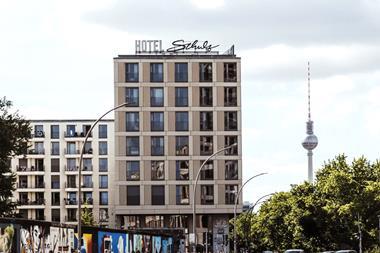Medical offices' stable cash flows and compelling demographics make them a safe haven for investors in an economic downturn, writes Lynn Strongin Dodds
The plight of commercial real estate has been well documented in the post-sub-prime world. While medical office properties have not been immune, they have managed to weather the storm better than most other property segments. Industry reports show that their annual rental growth averaged 2.6% from 2000 to 2007, more than twice the 1.3% rents for traditional office product.
First-quarter statistics from Real Capital Analytics revealed that in the US, there were $1.06bn-worth of transactions, 7% up the quarter before, although a 1.9% drop from a year earlier. Deal pace waned in April and May, reflecting the general nervousness in the property markets.
According to a recent report from Grubb & Ellis, a US-based commercial real estate investment and advisory firm, cap rates had compressed to 7% in 2007 from 9.7% in 2002, indicating that investors were willing to fork out more for the properties. However, in the short term, they are expected to rise as transactions fall due to investors becoming more risk-averse. In the long term, though, the research notes that medical properties are positioned to outperform other property types over the next 10 years.
This is mainly due to the recession resistant, non-cyclical nature of the demand for healthcare services, says Dan Prosky, executive vice president of acquisitions of Grubb & Ellis's Healthcare REIT in California. "Medical offices have never generated the double-digit returns that were seen with office buildings during the real estate boom. Instead, they produced steady and stable annual yields of 7-9%. The main advantage of these properties is that they will continue to grow in bad and good times unlike commercial real estate which has been badly hurt by the credit crunch."
Olin Needle, director of North American investment research at Heitman, a Chicago-based real estate investment management firm, agrees. "Unlike some niche property sectors, medical offices never belonged to an opportunity or value add fund. They do not have big spikes on either side but offer a low-risk, low volatility investment opportunity."
Another benefit is that doctors typically sign eight-year leases and have renewal rates of 90% compared with the conventional office market, where tenants typically sign three- to five-year leases and have 60% renewal rates. Steve Bolen, Baltimore-based portfolio manager of LaSalle Investment Management's medical office fund, says: "Investors view medical offices favourably because of their defensive nature, the stability of the tenant base and their ability to capitalise on favourable demographics in the US. Despite it being difficult to get financing since the credit crunch, the fundamentals and valuations have held up well."
Institutional investing in medical offices is a mainly US phenomenon, and not only reflects the coming of age of real estate as an asset class but also institutions' willingness to look beyond the traditional sectors for extra returns and diversification. While US domestic players have been the most active, now Israeli, Canadian and Kuwaiti investors have come onto the scene while there is growing interest from other the Middle-East, European and Australian institutions.
Jarrod Daddis, managing director of development and acquisitions for Denver-based NexCore Group, a private developer, owner and operator of medical office buildings, says: "Investing in medical offices is not new. Private investors have been active for the past 20 years. What is different is that institutions have been showing an interest although it still represents a small percentage of their overall real estate portfolio."
There are many reasons why the US dominates the medical office property field. The country's total public and private healthcare expenditures are expected to grow at an average annual rate of 6.7% from 2007 to 2017, according to a report by the Centers for Medicare & Medicaid Services, the federal agency that pays health care providers.
The US will spend a hefty 19.5% of gross domestic product on health care in 2017, up from 16.3% in 2007. Looking farther out, this is projected to leapfrog to 25% by 2030.
According to the OECD, in 2004 the US spent more than twice the average of developed countries within the OECD, which averaged around 9% that year. While some countries such as the UK have increased spending, the US still remains ahead.
Another driver is demographics. The over 65s are estimated to grow 36% between 2010 and 2020 compared with 9% for the general population, according to the US Census Bureau. Members of this age group are more frequent users of medical services, according to the National Ambulatory Medical Care Survey, which gathers information about the healthcare provided by office-based physicians. Its research reveals that individuals aged 65-74 made an average of 6.5 visits per capita to physicians' offices in 2005 compared with 3.3 visits per capita for all age groups. Those over 75 made an average of 7.7 visits per capita. Meanwhile, the average number of visits per capita for all age groups jumped from 2.7 in 1985 to 3.3 in 2005.
Equally as important have been the regulatory shifts that have primed the outpatient facility boom. The Centers for Medicare and Medicaid Services has exerted pressure on doctors to perform lower-risk procedures outside hospital settings. This has meant that medical office buildings no longer simply house a doctors' surgery and internist practice but can offer a range of services. These include day surgeries and scans to a full gamut of medical disciplines.
Bolen says: "Healthcare delivery in the US has evolved along the lines of an outpatient model. Procedures that were traditionally performed in a hospital setting are increasingly occurring in outpatient centres. Thanks to rapid improvements in medical technology, outpatient centres offer a safe and cost effective way of delivering healthcare to consumers."
Hospitals have been monetising their real estate assets and forming joint ventures with physicians to operate surgery centres and other outpatient services on campus or at satellite locations. Patients have spent nearly twice as much on outpatient care than they have on hospital care over the last decade, according to the Centre for Studying Health System Change, a policy research organisation in Washington, DC.
The main players in medical office buildings have typically been local or regional developers and property groups but there is also a growing band of established national firms that are making their mark. It is not an easy market to crack as participants need to be au fait with the ins and outs of healthcare. Hospitals may be willing to part with their real estate assets but administrators often are only willing to sell if the buyers have an established track record of working with physician-tenants.
LaSalle was one of the pioneers in this field, having launched its $100m medical office fund in 2001, while four years later Heitman invested some $250m in the sector. Other active participants include Grubb & Ellis, whose Healthcare REIT made its debut in 2006 and has since accumulated a portfolio worth about $574m. Meanwhile, Nexcore has been actively looking for properties for the past five years while, three years ago RREEF took the plunge.
Alan Billingsley, director, head of the Americas research, RREEF alternative investments, says: "In 2006, we decided that the medical sector had enormous potential and undertook a review to see how we could best take advantage of the real estate opportunities. We systematically studied the sector and decided that medical office buildings offered the most potential. We have bought 10 properties in the $20m to $40m range. We prefer buildings that are on a hospital's campus but if we do look off campus we like surgery centres that have a few specialisations and that are located in an affluent area."
RREEF is not alone in favouring on-campus medical building. Needle of Heitman says: "We have four to five properties that are on campus and one or two that are not. One of the advantages of on campus is that tenancy is sticky. Doctors like the idea of the close proximity between the hospital and the outpatient facility. The biggest risk is the financial health of the hospital which is why we spend a lot of time analysing the viability of the hospital, its location, its creditworthiness and the quality of the buildings."
Looking ahead, the jury is out as to whether the US model can be transplanted to other countries due to the vast differences in medical care provision and regulation. Marcus Sperber, head of UK real estate at BlackRock, says: "Doctors surgeries have become a more institutionally acceptable form of property investments in the UK over recent years. The government has been looking at different ways of distributing healthcare, such as introducing polyclinics which would house multiple primary health facilities under one roof. However, they have come under criticism particularly in rural areas where people want to keep their local surgeries and not have the services centralised and located farther away."
Plans are being drawn up for some 150 new centres in London, although Dr Richard Vautrey, deputy chairman of the British Medical Association's GPs' committee, has voiced the organisation's opposition. "This is a government plan that is potentially going to waste hundreds of millions of pounds of scarce NHS resources, creating very large health centres that many areas of the country simply don't need or want."
In the meantime, UK fund managers will continue to scout out opportunities for doctor surgeries. "The BlackRock UK Property Fund owns a portfolio of 144 doctors' surgeries with a value of circa £250m. Many have the potential to be expanded to include attached clinics," says Sperber.












